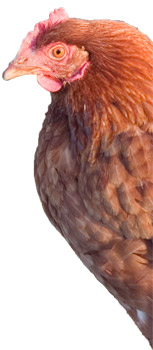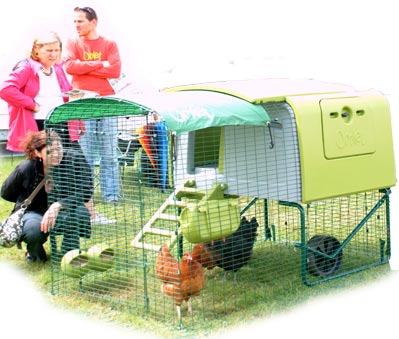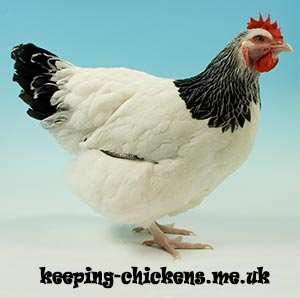Keeping a few chickens in the back yard really is quite straight forward; however there are some things to consider in order to get the right sort of birds for your situation and to keep them in the best possible health to get the most enjoyment out of keeping them.
This page hopes to get you thinking about the types of chickens and their requirements.
Choosing a breed
There are quite literally hundreds of different breeds of chicken to choose from and out of these, many have slightly different requirements.
Some breeds of chicken come only as Large Fowl, and others are also available as Bantams which are a smaller version that look the same. The Orpington for example is available in both large and bantam sizes but the Cochin is only available as large fowl.
There are a handful of ‘True Bantams’ where there is no large fowl equivalent. Examples of these are Dutch Bantams, Japanese Bantams and the popular Pekin Bantam.
Bantams tend to be quite flighty whereas the heavy breeds of large fowl often cannot fly more than a few inches off the ground. Orpingtons for example won’t usually roost very high due to their huge size and will usually just huddle on the floor of the coop.
Every breed is slightly different in the amount of eggs they lay. Typically hens that have been bred for exhibition purposes do not lay as well as utility hens. Bantams of course lay smaller eggs which some people say they prefer for taste.
Hybrids
 Hybrids are chickens that have been created by crossing pure breeds. They are typically crossed to make good layers (the hybrid to the right can lay 280 to 300 eggs!), coloured eggs or attractive hens. Some can be very attractive and they are all generally very hardy. Hybrids are produced in larger numbers that pure breeds and most of the crosses used make the males a different colour as day old chicks so that only females can be raised, therefore reducing costs by about half. A typical hybrid hen will cost you around £15 compare to £25 to £30 for a typical pure breed hen.
Hybrids are chickens that have been created by crossing pure breeds. They are typically crossed to make good layers (the hybrid to the right can lay 280 to 300 eggs!), coloured eggs or attractive hens. Some can be very attractive and they are all generally very hardy. Hybrids are produced in larger numbers that pure breeds and most of the crosses used make the males a different colour as day old chicks so that only females can be raised, therefore reducing costs by about half. A typical hybrid hen will cost you around £15 compare to £25 to £30 for a typical pure breed hen.
Hybrids are a good choice if eggs are one of your priorities although if you think you might like to hatch some eggs, remember hybrid hens do not breed true – you would need the original pure breeds to cross again in order to create more of the same thing so whilst you can hatch their eggs, you may want to consider a few pure breeds for this purpose or consider buying in eggs to hatch.
Free Range
You will of course need a chicken coop but also a secure run or area that is predator proof. A question that people always ask me is “How big should their run be?” I always say “as big as possible within reason.” Even 2 chickens kept in a 2 meter run will soon turn it to mud and get bored (which can introduce vices such as feather pecking and egg eating) but I always believe that it’s fine to provide a small run like this if you can let them out for a few hours each day to free range while you are around. This will give them a chance to forage, supplement their diet and reduce boredom.
Once chickens have settled into their new house, they will go back to it to roost every night so you can let them out in the late afternoon, knowing they will come back to roost at night keeping everyone happy! Some houses and runs have handles or wheels that make them easy to move onto fresh ground which is not only good to prevent a build up of worm eggs and disease but also provides them with a little fresh grass to graze.
Keeping Chickens in the Garden
If you have a ‘nice’ garden that you don’t want spoilt, it’s usually a sensible idea to limit their foraging. Chickens scratch at the ground, make dust baths in the dry soil, leave muck wherever they go and destroy tender young plants. If you can plant in pots, this will help and fencing off part of the garden is usually a good choice to keep them out if you have tender or precious plants. Chickens with feathered feet scratch less and bantams can clear a 6 foot fence if they want to. Heavy breeds of large fowl can be kept out with a knee high fence or box hedge. If you want to stop a bird from flying then you can clip one wing (not both).
So you have decided on the breed that’s right for you and your circumstances. Next, you will need to think about keeping them secure from predators in a suitable chicken house and chicken run – click on a link to go to that page!








I rescued 3 girls from the battery 14 months ago. Henrietta passed away thre weeks ago and sadly Hilda died yesturday leaving Harriet alone. Will Harriet be ok on her own.
Chickens are flock animals and should be kept as a minimum in a pair, ideally a trio.
We’ve had a couple of chickens for a few months now and love them and the eggs but are not too keen on the mess they have made in the garden as it limits the children’s enjoyment of the garden. We have them in a 2m run but let them out a few hours each day. We couldn’t bare not letting them out as we feel this would be cruel so think the only answer is fencing them in. What would you say is the minimum area the fence should be and should it include anything in particular, such as bush area and mud? The run is a mud area with wood chippings. We want to achieve a happy medium between area of child play and area for chicken play. The garden is about 10m by 10m so not huge. Also any recommendations on height of fence and material? Any advice is welcomed.
That sounds like the best plan. They should be able to find shade and shelter from the wind and rain at all times but other than than, most garden areas will be fine. There is some information here on Poultry Fencing that might help you.
Hi there im getting 4 hens next week i have ordered a 6-8 chicken house (i heard they could be small so wanted plenty room) with an 8ft run. is it ok to keep the chickens on a paved area? I thought this would be easier to clean i would let them out in afternoons to go on grass. But didnt know if they would get frustated in run and peck each other??
Have a read of my page on Chicken Runs. It is better to provide a substrate that can be changed from time to time and allows them to scratch / dust bath etc.
My son and I are thinking of having 3 chickens. We are completely new to keeping chickens – our back yard is slabs, pebbles and privet hedges, is this a suitable envoronment for chickens? A friend has said yes, but I imagined they would prefer a grassed area to peck at…. in which case I don’t mind making such an area. We were thinking of getting a wooden chicken house and run – someone has suggested moving the chickens into the garage at night for safety as we live in area popular with urban foxes. Would this upset them a bit? If we have one chicken house in the yard and then move them to a different place at night, is this going to cause confusion? Or do we try leaving them in the chicken house in the yard and see how it goes? Thanks
They don’t -HAVE- to have grass although it can make up a good part of their diet. If they get lots of greens, they will be fine. The trick is to provide them with a good substrate to scratch around in that can be periodically changed when it gets messy (see my page on Chicken Runs). I wouldn’t go to the trouble of moving them at night. An urban fox is brave enough to visit in the daytime, especially when feeding young so they will need to be in a fox proof house and run in the daytime anyway when you’re not around. Give them as much space as you can and they will be really happy.
Hi, i’m getting some chickens for the first time and i know i’m getting a Polish chicken but can you keep different breeds in the same coop/pen?
Yes you can – ensure they are all a similar size so that there is no bullying.